LECTURE ON Medical Ethics JALAL-ABAD STATE UNIVERSITY MEDICAL


LECTURE ON Medical Ethics JALAL-ABAD STATE UNIVERSITY MEDICAL FACULTY

How are medical science and ethics related? What is medical science? What is Ethics?

Nowadays, conflicts of interests between the government and medical institutions, between medical institutions and medical personnel, between physicians and patients are getting more and more serious and complex. Why Ethics Become Important?

High technologies not only brought us hopes of cure but have also created a heavy economic burden. The ethical dilemmas of high technology medicine-brain death, organ transplantation, and concerns about quality of life-have become increasingly prominent.

A new and more specific code of ethics must be developed to meet the demands of social development and medical service. This new code integrates the traditional medical ethics with modern principles and values.

Section 1: Morality, Ethics Section 2: Professional ethics, medical ethics, bioethics, clinical ethics Section 3: The History of Medical Ethics

Section 1: Morality, Ethics 1.What is Morality 2.What is Ethics? 3.Ethics and Morality 4.to distinguish between Ethics and Law 5.to distinguish between Ethics and Policy

The science of human duty; the rules of human conduct. The function of morality is "to combat the deleterious consequences of human sympathies" (Beauchamp). Its aim is "to contribute to betterment -- or at least non-deterioration -- of the human predicament" (Warnock). "Ethics aims at discovering what are those other properties belonging to all things which are good" (Moore). 1.What is Morality

2.What is Ethics? Ethics are standards of conduct (or social norms) that prescribe behavior. Ethics as a field of study is a normative discipline whose main goals are prescriptive and evaluative rather than descriptive and explanatory. So Ethicists are different from social scientists. Ethicists (or moral philosophers) study standards of conduct.

But standards of conduct do not describe our actual behavior, since people often violate widely accepted standards. For Example, most people accept the idea that one ought to tell the truth, yet many people lie all of the time. Even though people lie all of the time, we indicate our endorsement of honesty as a standard of conduct by defending honesty in public, by teaching our children/students to be honesty, and by expressing our disapproval of lying.

In thinking about standards of conduct, it will be useful to distinguish between “ethics” and “morality”. Morality consists of a society’s most general standards. These standards apply to all people in society regardless of their professional or institutional roles. Moral standards include those rules that most people learn in childhood, e.g. “don’t lie, cheat, steal, harm other people, etc.” Many ethicists maintain that moral duties and obligations override other ones: so, “if I have a moral duty not to lie, then I should not lie even if my employment requires me to lie.”

3.Ethics and Morality So that we can see, moral standards distinguish between right and wrong, good and bad, virtue and vice, justice and injustice. Ethics are not general standards of conduct but the standards of a particular profession, occupation, institution, or group within society. The word “ethics”, when used in this way, usually serves as a modifier for another word, e.g. business ethics, medical ethics, sports ethics, military ethics, etc. They are all professional ethics.

4.to distinguish between Ethics and Law (1) some actions that are illegal may not be unethical. (kill) (2) some actions that are unethical may not be illegal. (secret) (3) laws can be unethical or immoral. (Nazi’s) (4) we use different kinds of mechanisms to express, teach, inculcate, and enforce laws and ethics.

Laws are often expressed in highly technical and complex forms, and we often need specially trained people---lawyers and judges---to interpret them. Ethics and morals tend to be less technical and complex. (5) we use the coercive power of government to enforce laws. People who break certain laws can be fined, imprisoned, or executed. People who violate ethical or moral standards do not face these kind of punishments unless their action also violate laws. We often “punish” people who disobey moral or ethical obligations by simply expressing our disapproval or by condemning the behavior.

5.to distinguish between Ethics and Policy Political standards focus on the conduct of groups or social institutions, whereas ethical and moral standards focus on the conduct of individuals. Political standards take a macro-perspective on human affairs; ethical and moral standards adopt a micro-perspective. However, the distinction between ethics and politics is not absolute since many actions, institutions, and situations can be evaluated from an ethical or political point of view.

Section 2: Professional ethics, medical ethics, bioethics, clinical ethics

1.Professional Ethics Professional ethics are standards of conduct that apply to people who occupy a professional occupation or role. A person who enters a profession acquires ethical obligations because society trusts them to provide valuable goods and services that cannot be provided unless their conduct conforms to certain standards. Professionals who fail to live up to their ethical obligations betray this trust. Professional ethics studied by ethicists include medical ethics.

2.Medical ethics The expressions “professional ethics” and “medical ethics” were coined by Thomas Percival. Medical ethics is a special kind of ethics only as it relates to a particular realm of facts and concerns and not because it embodies or appeals to some special moral principles or methodology.

It is applied ethics. It consists of the same moral principles and rules that we would appeal to ,and argue for, in ordinary circumstances. It is just that in medical ethics these familiar moral rules are being applied to situations peculiar to the medical world.
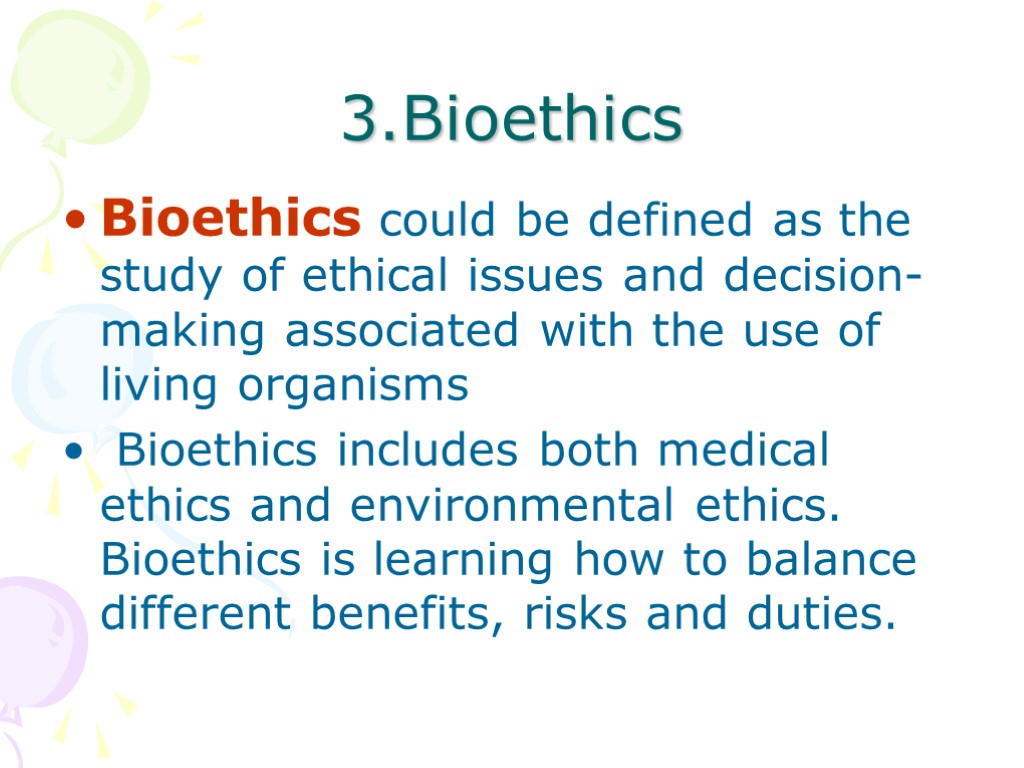
3.Bioethics Bioethics could be defined as the study of ethical issues and decision-making associated with the use of living organisms Bioethics includes both medical ethics and environmental ethics. Bioethics is learning how to balance different benefits, risks and duties.

4.Clinical ethics Clinical ethics is a practical discipline that provides a structured approach for identifying ,analyzing, and resolving ethical issues in clinical medicine.

Clinical medical ethics is a practical and applied discipline that aims to improve patient care and patient outcomes by focusing on reaching a right and good decision in individual cases. It focuses on the doctor-patient relationship and takes account of the ethical and legal issues that patients, doctors, and hospitals must address to reach good decisions for individual patients.

Clinical ethics emphasizes that in practicing good clinical medicine, physicians must combine scientific and technical abilities with ethical concerns for the personal values of the patients who seek their help.
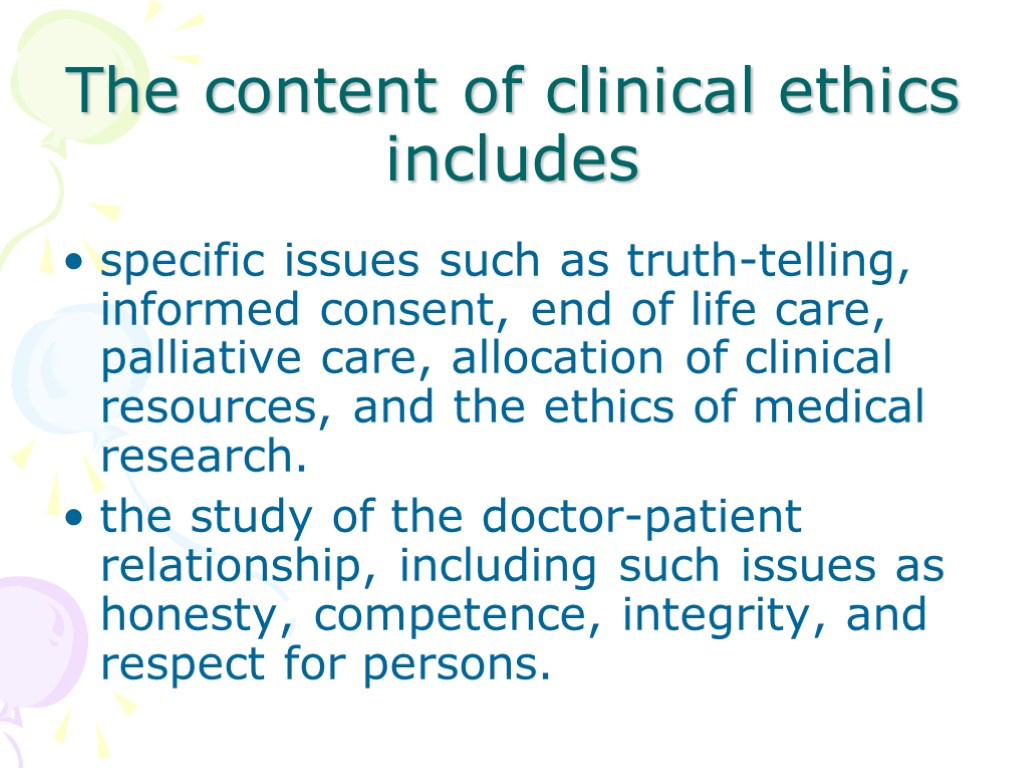
The content of clinical ethics includes specific issues such as truth-telling, informed consent, end of life care, palliative care, allocation of clinical resources, and the ethics of medical research. the study of the doctor-patient relationship, including such issues as honesty, competence, integrity, and respect for persons.

Section 3: The History of Medical Ethics
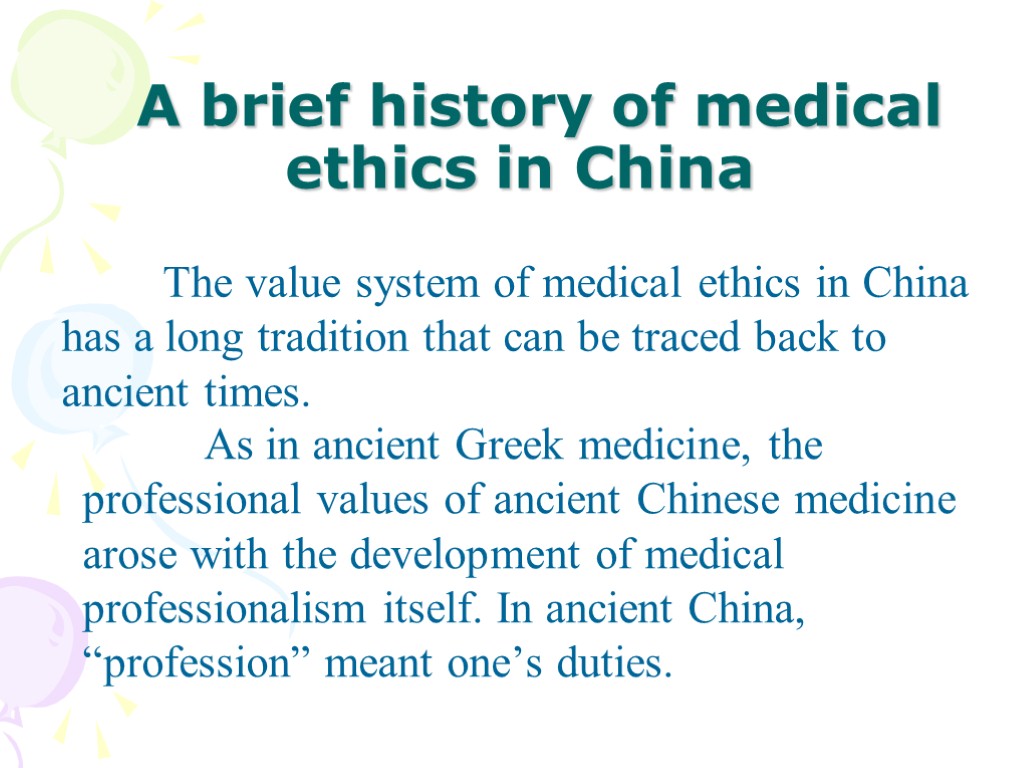
A brief history of medical ethics in China The value system of medical ethics in China has a long tradition that can be traced back to ancient times. As in ancient Greek medicine, the professional values of ancient Chinese medicine arose with the development of medical professionalism itself. In ancient China, “profession” meant one’s duties.
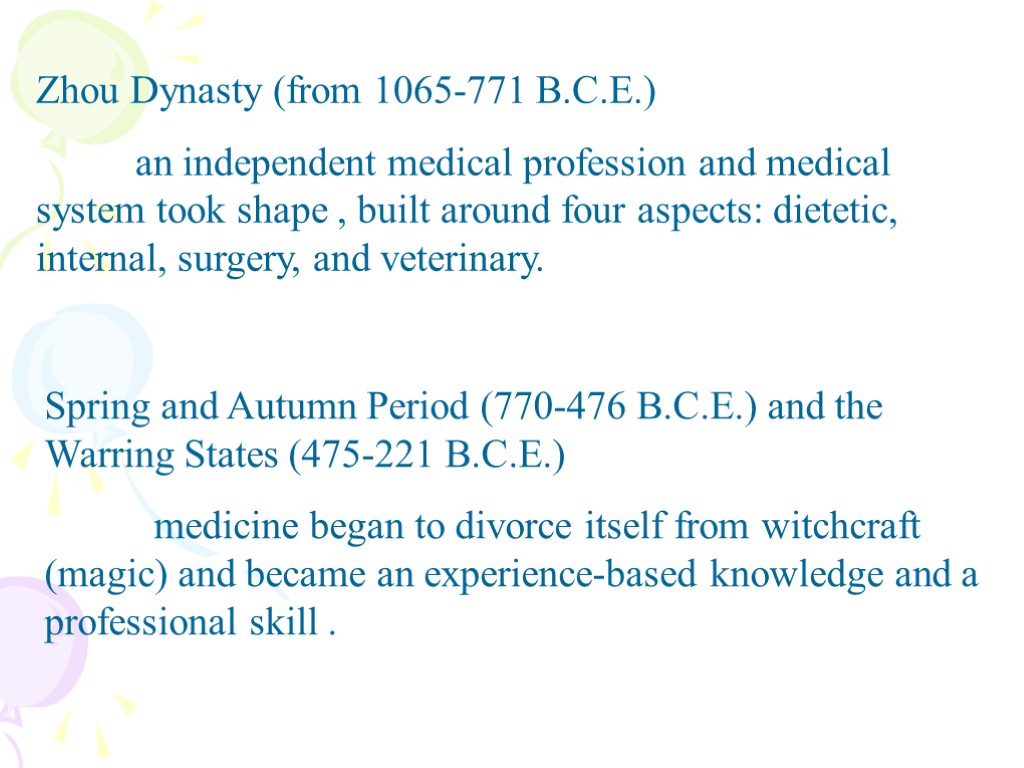
Zhou Dynasty (from 1065-771 B.C.E.) an independent medical profession and medical system took shape , built around four aspects: dietetic, internal, surgery, and veterinary. Spring and Autumn Period (770-476 B.C.E.) and the Warring States (475-221 B.C.E.) medicine began to divorce itself from witchcraft (magic) and became an experience-based knowledge and a professional skill .
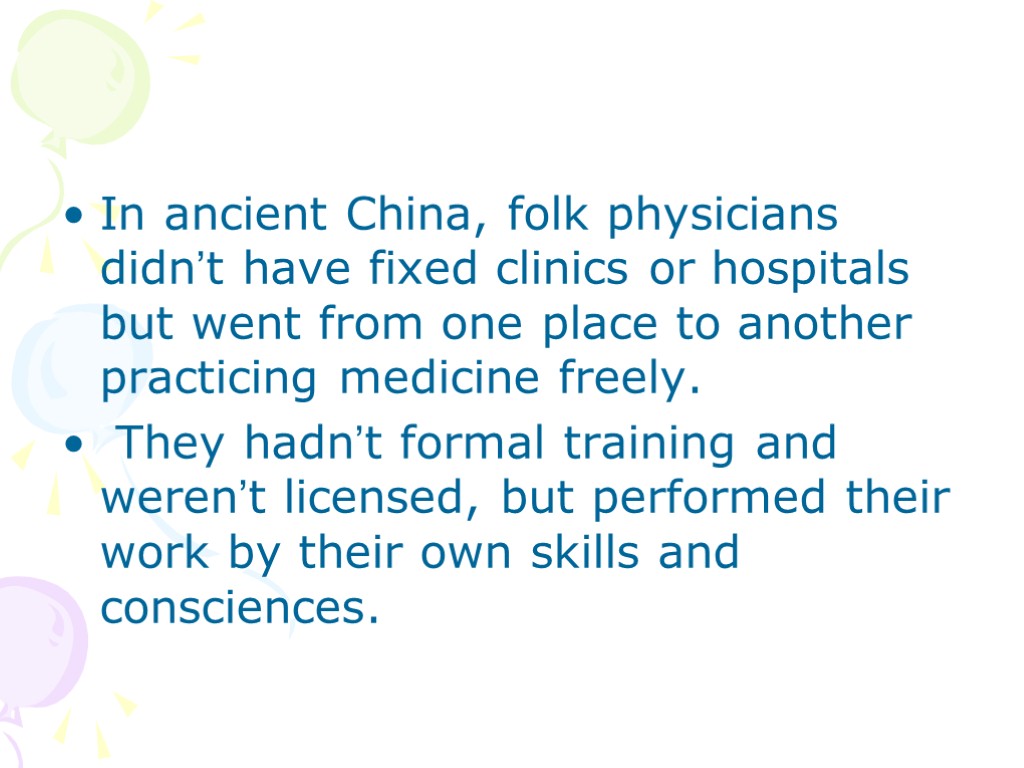
In ancient China, folk physicians didn’t have fixed clinics or hospitals but went from one place to another practicing medicine freely. They hadn’t formal training and weren’t licensed, but performed their work by their own skills and consciences.
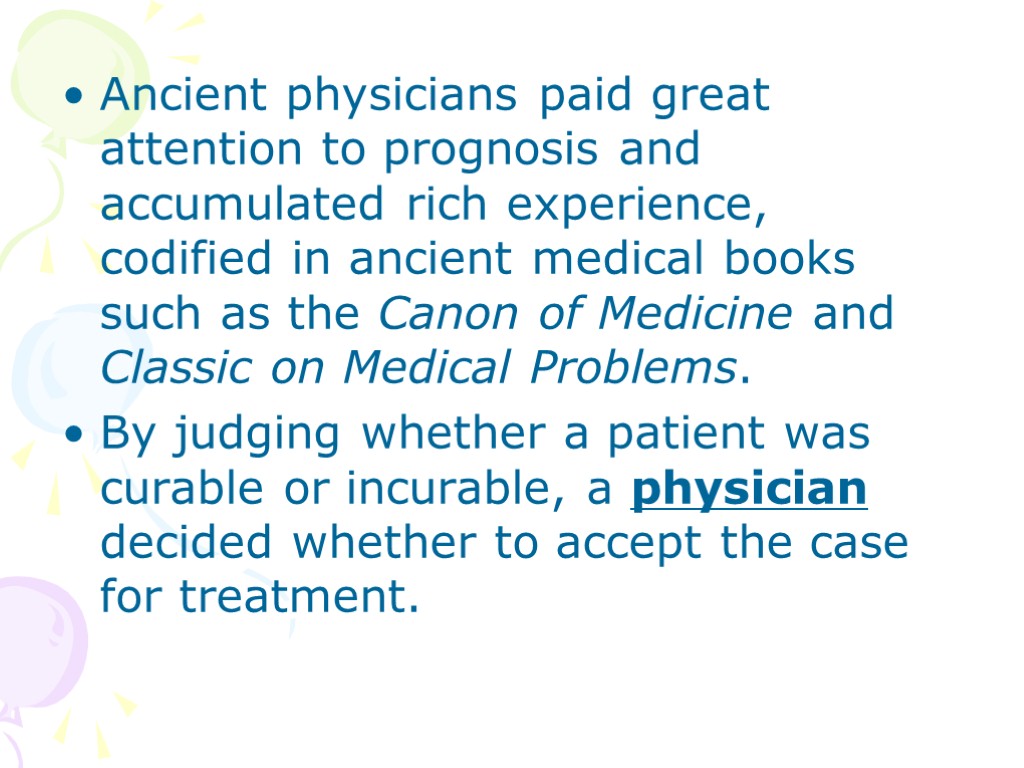
Ancient physicians paid great attention to prognosis and accumulated rich experience, codified in ancient medical books such as the Canon of Medicine and Classic on Medical Problems. By judging whether a patient was curable or incurable, a physician decided whether to accept the case for treatment.
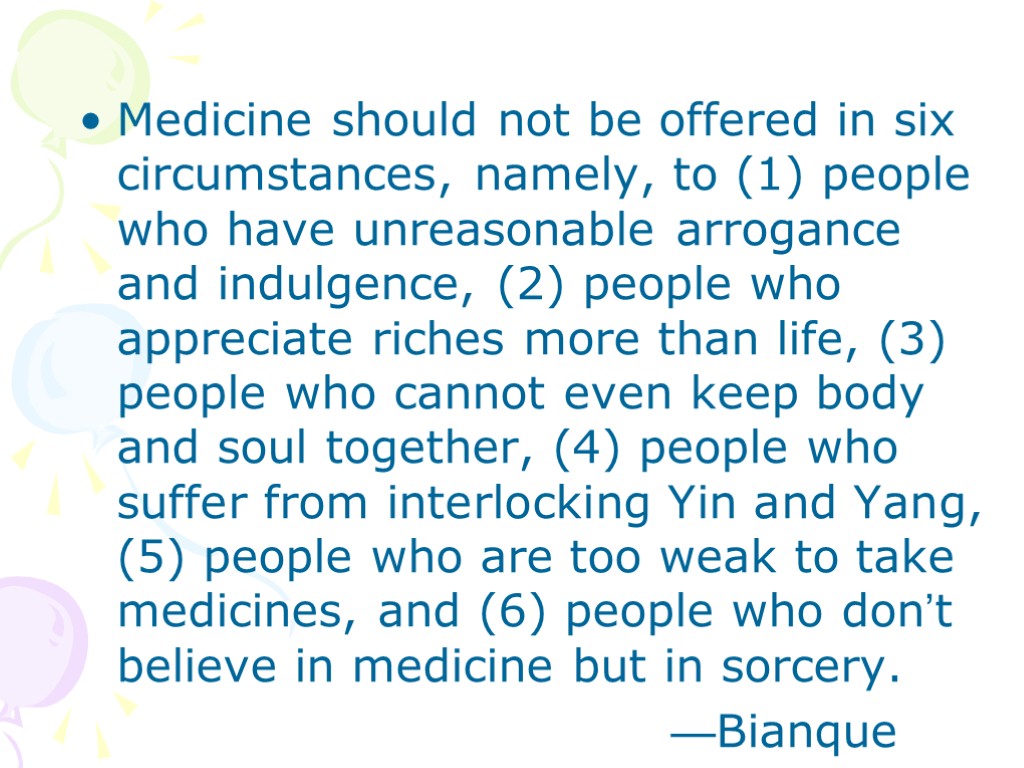
Medicine should not be offered in six circumstances, namely, to (1) people who have unreasonable arrogance and indulgence, (2) people who appreciate riches more than life, (3) people who cannot even keep body and soul together, (4) people who suffer from interlocking Yin and Yang, (5) people who are too weak to take medicines, and (6) people who don’t believe in medicine but in sorcery. —Bianque
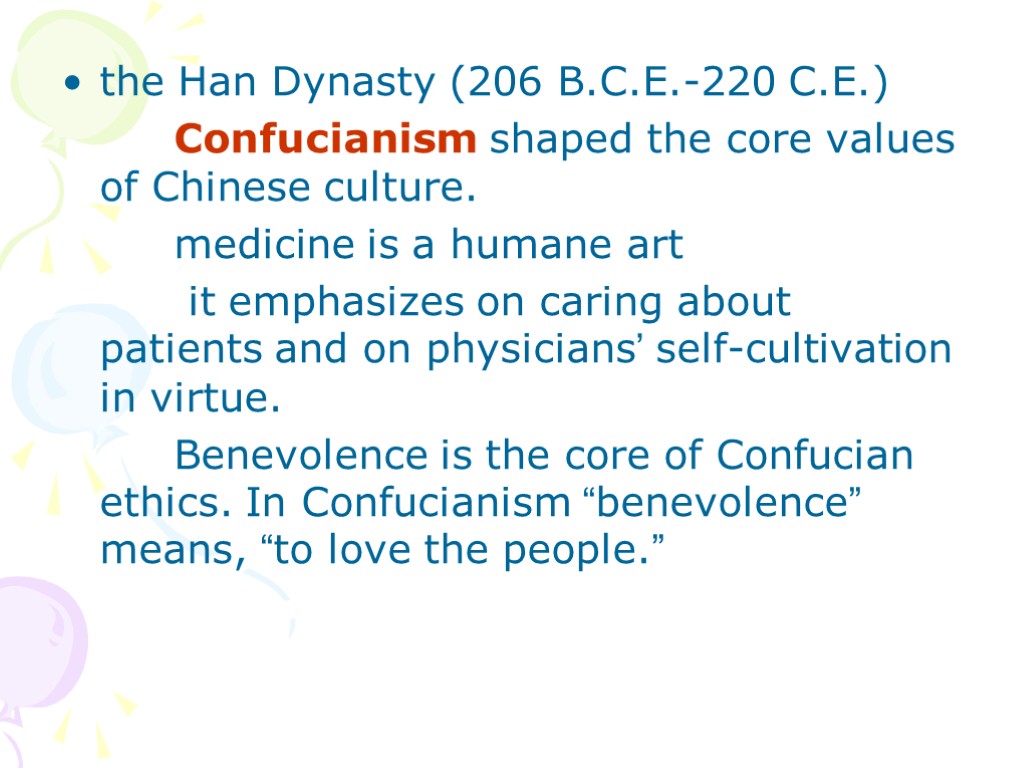
the Han Dynasty (206 B.C.E.-220 C.E.) Confucianism shaped the core values of Chinese culture. medicine is a humane art it emphasizes on caring about patients and on physicians’ self-cultivation in virtue. Benevolence is the core of Confucian ethics. In Confucianism “benevolence” means, “to love the people.”
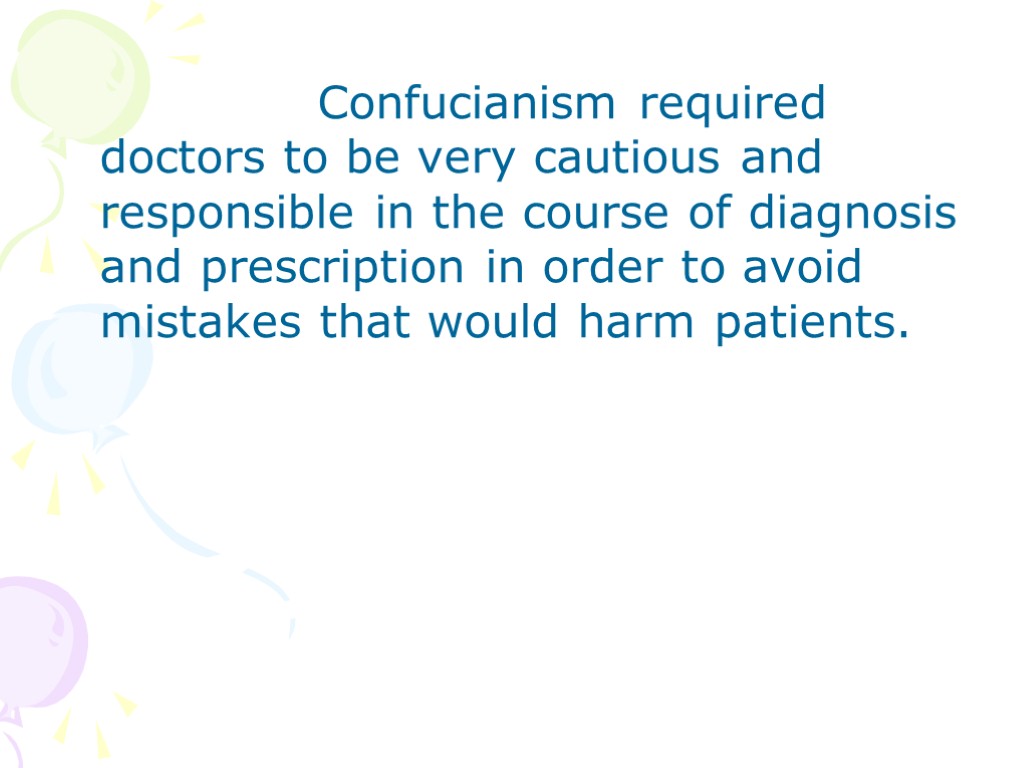
Confucianism required doctors to be very cautious and responsible in the course of diagnosis and prescription in order to avoid mistakes that would harm patients.
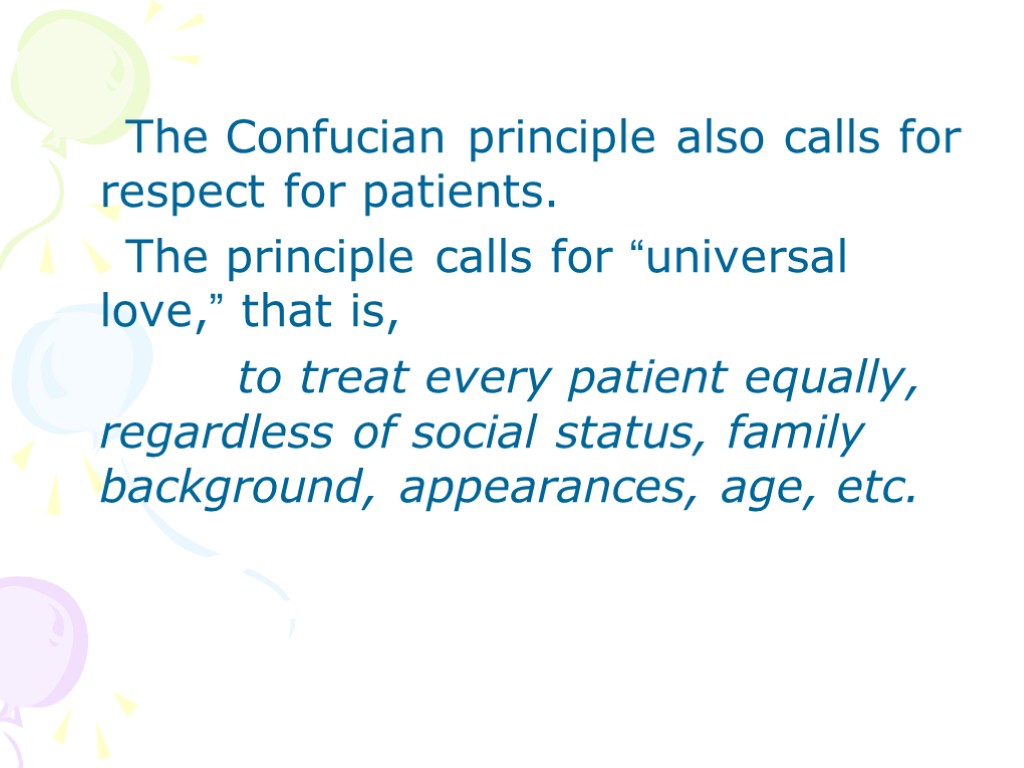
The Confucian principle also calls for respect for patients. The principle calls for “universal love,” that is, to treat every patient equally, regardless of social status, family background, appearances, age, etc.
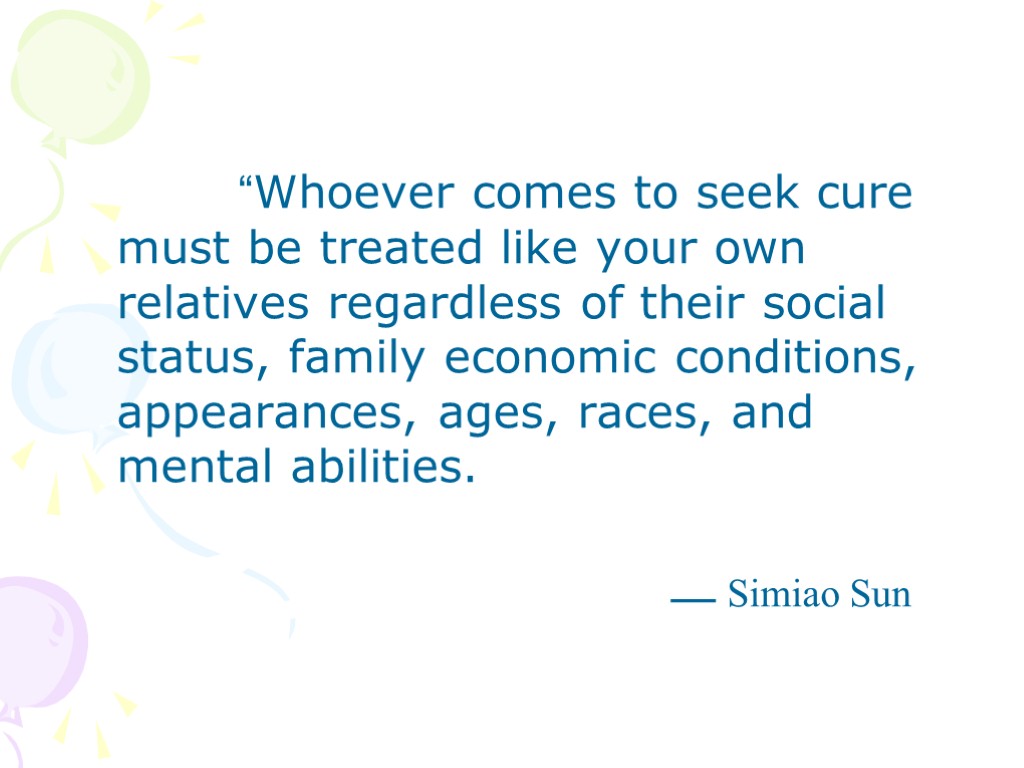
“Whoever comes to seek cure must be treated like your own relatives regardless of their social status, family economic conditions, appearances, ages, races, and mental abilities. — Simiao Sun
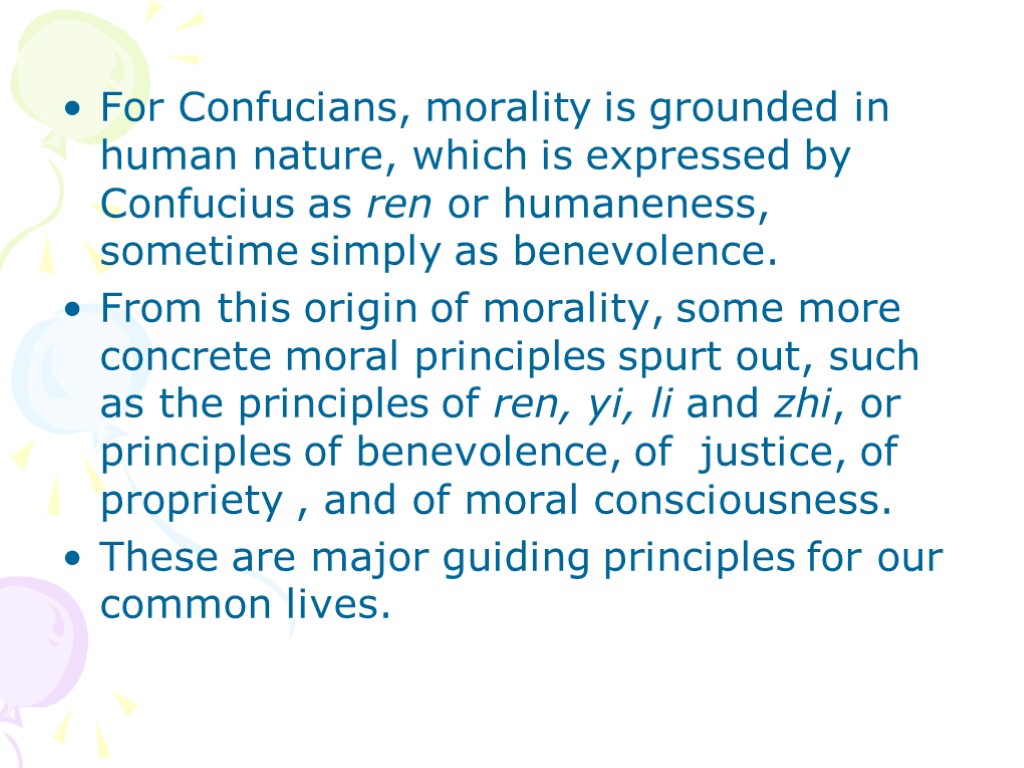
For Confucians, morality is grounded in human nature, which is expressed by Confucius as ren or humaneness, sometime simply as benevolence. From this origin of morality, some more concrete moral principles spurt out, such as the principles of ren, yi, li and zhi, or principles of benevolence, of justice, of propriety , and of moral consciousness. These are major guiding principles for our common lives.
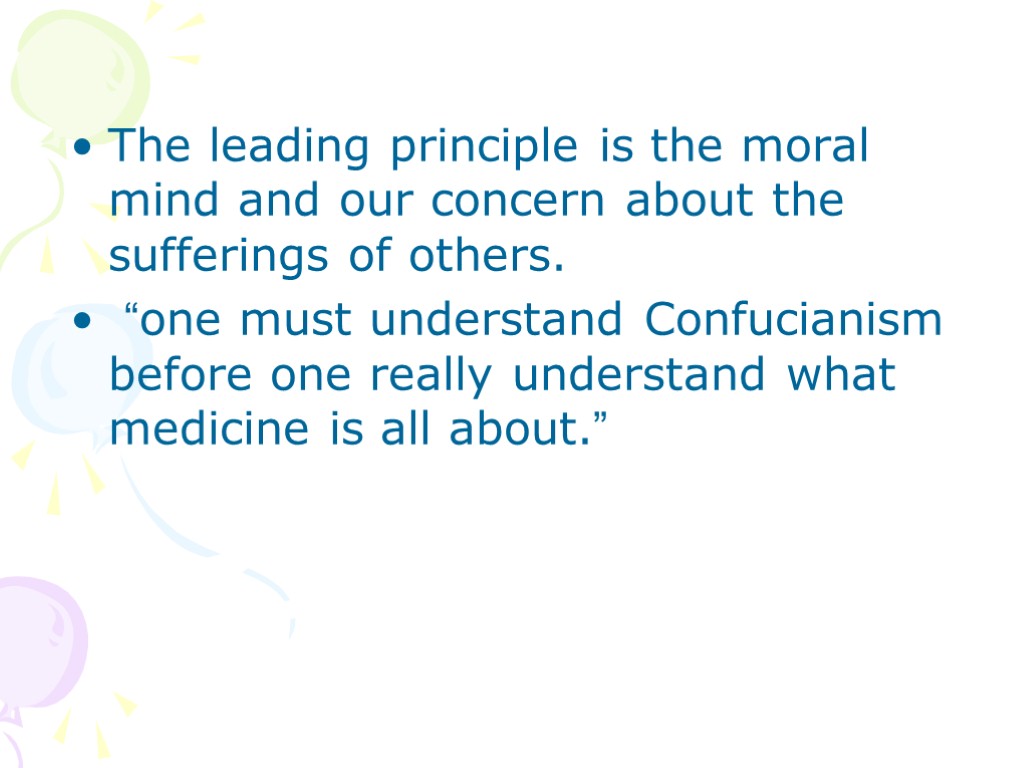
The leading principle is the moral mind and our concern about the sufferings of others. “one must understand Confucianism before one really understand what medicine is all about.”
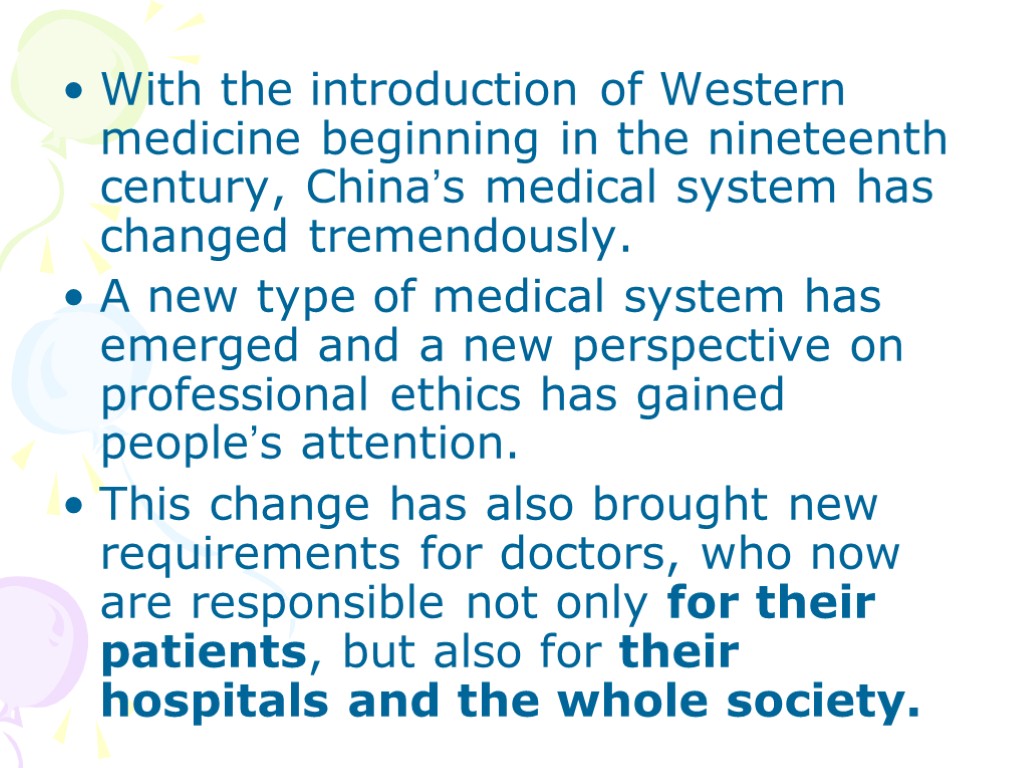
With the introduction of Western medicine beginning in the nineteenth century, China’s medical system has changed tremendously. A new type of medical system has emerged and a new perspective on professional ethics has gained people’s attention. This change has also brought new requirements for doctors, who now are responsible not only for their patients, but also for their hospitals and the whole society.
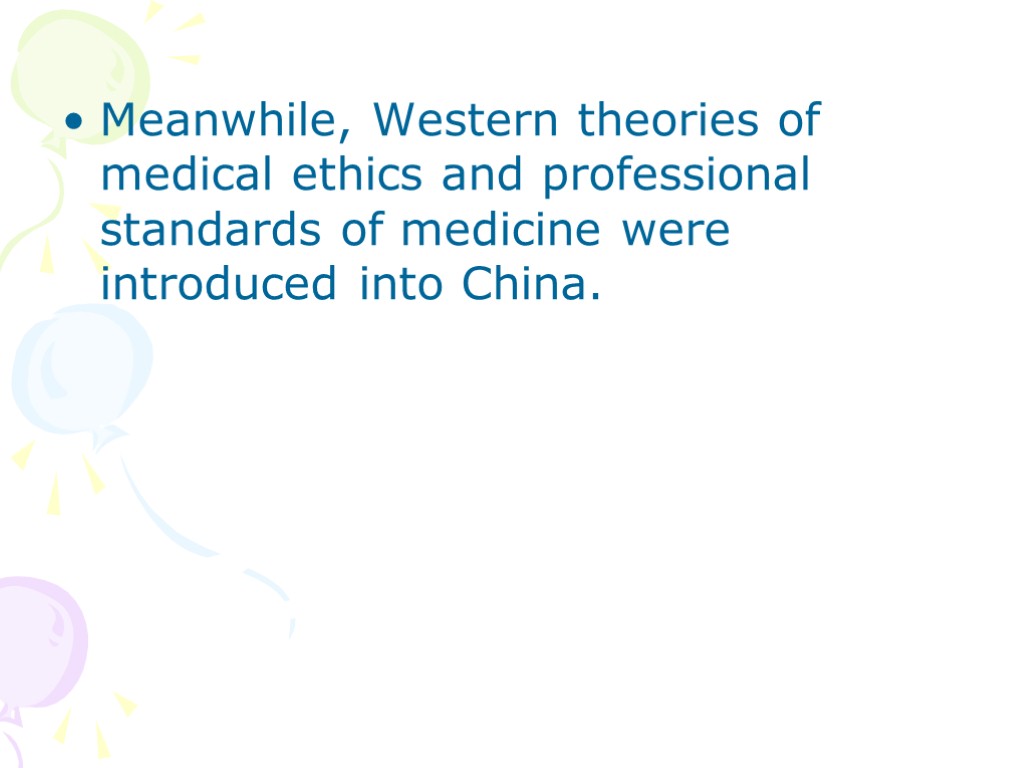
Meanwhile, Western theories of medical ethics and professional standards of medicine were introduced into China.
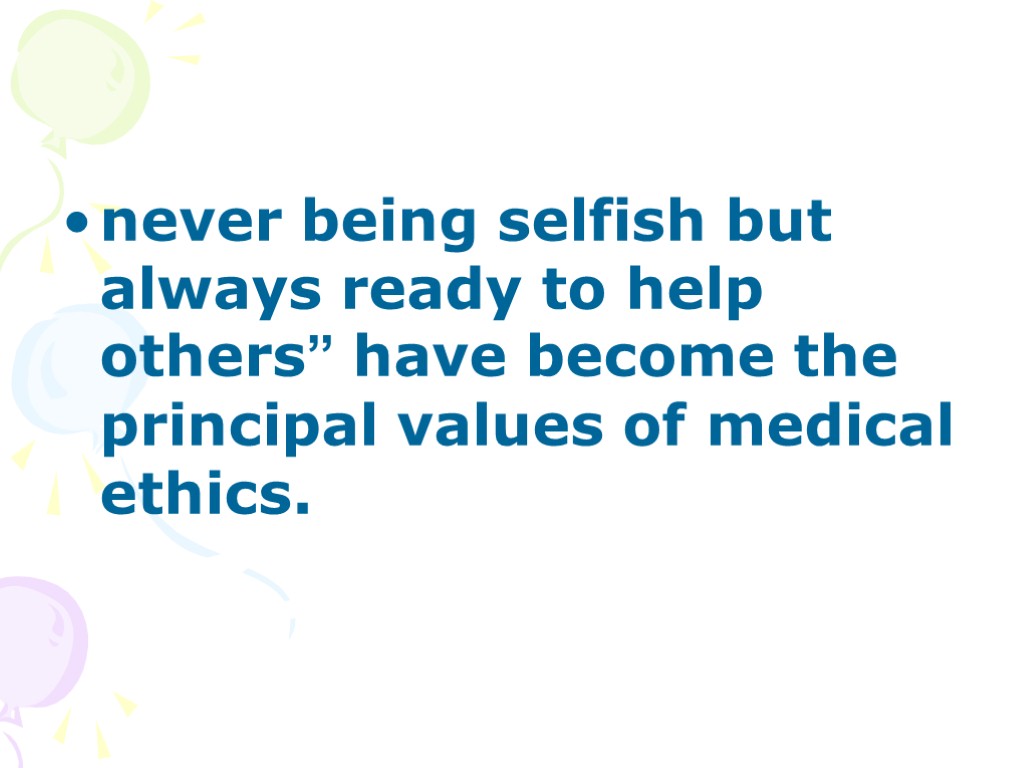
never being selfish but always ready to help others” have become the principal values of medical ethics.
meical_etics.ppt
- Количество слайдов: 39

